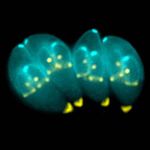Difference between revisions of "Protozoa Flashcards"
Jump to navigation
Jump to search
m (→Piroplasmida) |
|||
| Line 257: | Line 257: | ||
==<font color="purple">Tissue Cyst Forming Coccidia</font>== | ==<font color="purple">Tissue Cyst Forming Coccidia</font>== | ||
| + | {| border="3" cellpadding="8" | ||
| + | !width="400"|'''Question''' | ||
| + | !width="400"|'''Answer''' | ||
| + | !width="150"|'''Article''' | ||
| + | |- | ||
| + | |<big>'''What are the two main species of ''Neospora'' of veterinary interest and which animals do they affect?''' | ||
| + | ||<font color="white"> <big> | ||
| + | *'''''N. caninum''''' | ||
| + | **'''''Dogs''''' | ||
| + | *'''''N. hughesi''''' | ||
| + | **'''''Horses''''' | ||
| + | ||[[Tissue cyst-forming coccidia#Neospora|<span title="Answer article">Link to Answer Article</span>]] | ||
| + | |} | ||
| + | |||
==<font color="purple">Tropical Protozoa</font>== | ==<font color="purple">Tropical Protozoa</font>== | ||
==<font color="purple">Other Important Protozoa</font>== | ==<font color="purple">Other Important Protozoa</font>== | ||
Revision as of 20:19, 10 January 2009
|
|
Protozoa
| Question | Answer | Article |
|---|---|---|
| What are the four different ways protozoa can move? |
|
Link to Answer Article |
| How do protozoa reproduce? |
|
Link to Answer Article |
| Briefly summarise the life cycle of protozoa |
|
Link to Answer Article |
Coccidia
| Question | Answer | Article |
|---|---|---|
| What is the transmission and life cycle of Eimeria species? |
|
Link to Answer Article |
| What is the transmission and life cycle of Isospora species? |
|
Link to Answer Article |
| How long is the prepatent period of poultry Eimeria species? |
|
Link to Answer Article |
| Name the malabsorptive Eimeria species |
|
Link to Answer Article |
| Name the haemorrhagic Eimeria species |
|
Link to Answer Article |
| Which area of the gastrointestinal tract does E. acervulina, E. maxima, E. tenella and E. necatrix affect and what kind of lesions are produced? |
|
Link to Answer Article |
| What are the two main Eimeria species which affect cattle and what is the prepatent period? |
|
Link to Answer Article |
| What are the two significant Eimeria species which affect sheep and what is the prepatent period? |
|
Link to Answer Article |
| What is the most significant species of Isospora which affects pigs and what the prepatent period? |
|
Link to Answer Article |
| Which parts of the gastrointestinal tract do the Eimeria species which affects rabbits inhabit? |
|
Link to Answer Article |
Cryptosporidia
| Question | Answer | Article |
|---|---|---|
| What is the main species of Cryptosporidium which infects humans and domestic animals? |
|
Link to Answer Article |
| True or False: In Cryptosporidium infections unsporulated oocysts are passed in the faeces |
|
Link to Answer Article |
| How are Cryptosporidium infections passed between hosts? |
|
Link to Answer Article |
| How are Cryptosporidium infections prevented? |
|
Link to Answer Article |
Giardia
| Question | Answer | Article |
|---|---|---|
| What is the key points of the life cycle and prepatent period of Giardia? |
|
Link to Answer Article |
| How do both people and animals become infected by Giardia? |
|
Link to Answer Article |
| How would you diagnose a Giardia infection? |
|
Link to Answer Article |
Piroplasmida
| Question | Answer | Article |
|---|---|---|
| True or False: Both trans-stadial and trans-ovarian transmission can occur in Babesia species |
|
Link to Answer Article |
| What are the recognisable features of small Babesia species and give an example |
|
Link to Answer Article |
| What are the recognisable features of large Babesia species and give an example |
|
Link to Answer Article |
| What are the predisposing features to Babesia infection? |
|
Link to Answer Article |
| What are the different vectors for Babesia species? |
|
Link to Answer Article |
| What species are the natural vectors for Cytauxzoon? |
|
Link to Answer Article |
| Where do schizonts of Cytauxzoon felis develop? |
|
Link to Answer Article |
| What is the main condition caused by Theileria parva? |
|
Link to Answer Article |
| What is the main condition caused by Theileria parva and what is the intermediate host? |
|
Link to Answer Article |
| What is the pathogenesis of Theileria parva infections? |
|
Link to Answer Article |
| What are the clinical signs of Theileria parva infection? |
|
Link to Answer Article |
Tissue Cyst Forming Coccidia
| Question | Answer | Article |
|---|---|---|
| What are the two main species of Neospora of veterinary interest and which animals do they affect? |
|
Link to Answer Article |
